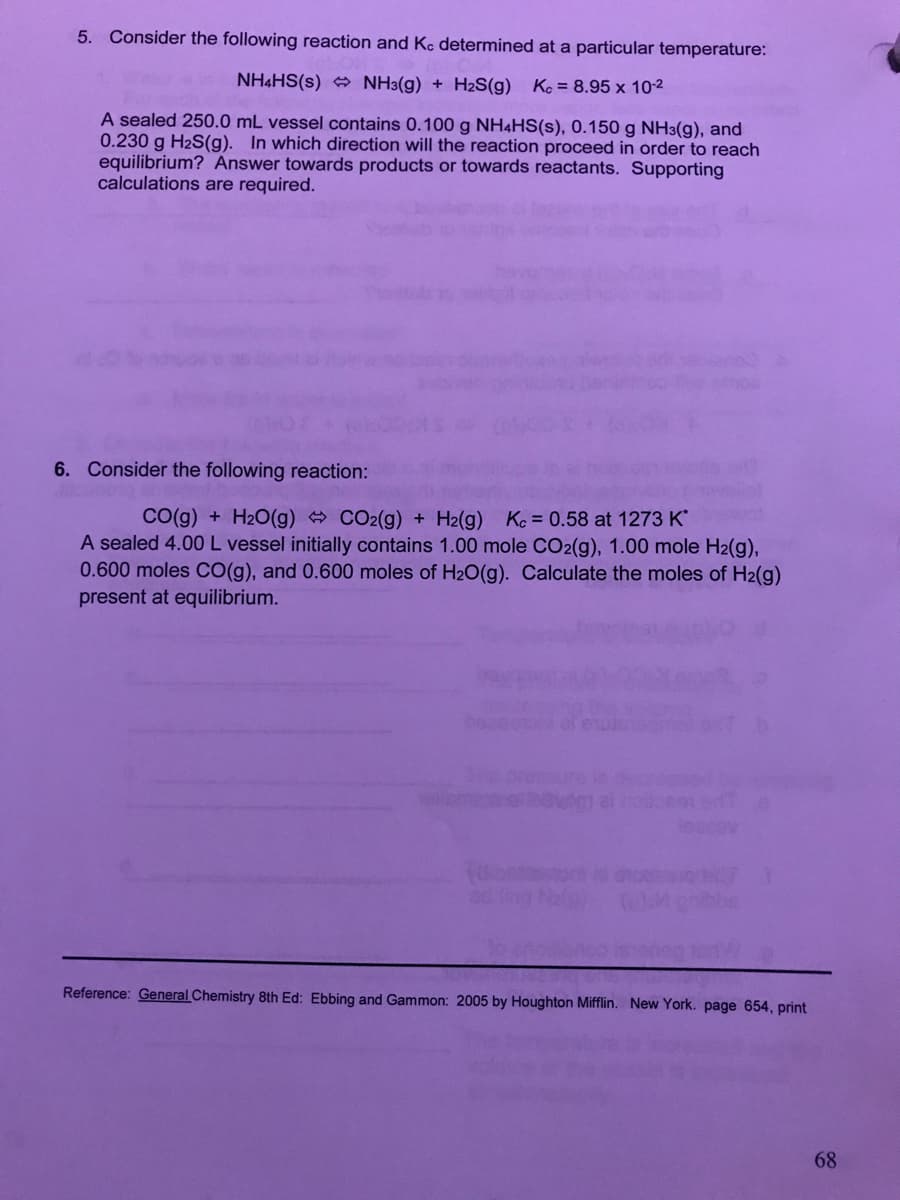Consider the following reaction and Kc determined at a particular temperature: NH4HS(s) NH3(g) + H2S(g) Ko= 8.95 x 10-2 A sealed 250.0 mL vessel contains 0.100 g NH4HS(s), 0.150 g NH3(g), and 0.230 g H2S(g). In which direction will the reaction proceed in order to reach equilibrium? Answer towards products or towards reactants. Supporting calculations are required.
Consider the following reaction and Kc determined at a particular temperature: NH4HS(s) NH3(g) + H2S(g) Ko= 8.95 x 10-2 A sealed 250.0 mL vessel contains 0.100 g NH4HS(s), 0.150 g NH3(g), and 0.230 g H2S(g). In which direction will the reaction proceed in order to reach equilibrium? Answer towards products or towards reactants. Supporting calculations are required.
General, Organic, and Biological Chemistry
7th Edition
ISBN:9781285853918
Author:H. Stephen Stoker
Publisher:H. Stephen Stoker
Chapter9: Chemical Reactions
Section: Chapter Questions
Problem 9.21EP: Classify each of the following reactions as (1) a redox reaction (2) a nonredox reaction or (3) cant...
Related questions
Question
100%

Transcribed Image Text:5. Consider the following reaction and Kc determined at a particular temperature:
NH4HS(s) NH3(g) + H2S(g) Ko = 8.95 x 10-2
A sealed 250.0 mL vessel contains 0.100 g NH4HS(s), 0.150 g NH3(g), and
0.230 g H2S(g). In which direction will the reaction proceed in order to reach
equilibrium? Answer towards products or towards reactants. Supporting
calculations are required.
6. Consider the following reaction:
Co(g) + H2O(g) → CO2(g) + H2(g) Ko = 0.58 at 1273 K
A sealed 4.00 L vessel initially contains 1.00 mole CO2(g), 1.00 mole H2(g),
0.600 moles CO(g), and 0.600 moles of H2O(g). Calculate the moles of H2(g)
present at equilibrium.
Reference: General Chemistry 8th Ed: Ebbing and Gammon: 2005 by Houghton Mifflin. New York. page 654, print
68
Expert Solution
This question has been solved!
Explore an expertly crafted, step-by-step solution for a thorough understanding of key concepts.
This is a popular solution!
Trending now
This is a popular solution!
Step by step
Solved in 5 steps

Knowledge Booster
Learn more about
Need a deep-dive on the concept behind this application? Look no further. Learn more about this topic, chemistry and related others by exploring similar questions and additional content below.Recommended textbooks for you

General, Organic, and Biological Chemistry
Chemistry
ISBN:
9781285853918
Author:
H. Stephen Stoker
Publisher:
Cengage Learning

Chemistry & Chemical Reactivity
Chemistry
ISBN:
9781133949640
Author:
John C. Kotz, Paul M. Treichel, John Townsend, David Treichel
Publisher:
Cengage Learning

Chemistry
Chemistry
ISBN:
9781305957404
Author:
Steven S. Zumdahl, Susan A. Zumdahl, Donald J. DeCoste
Publisher:
Cengage Learning

General, Organic, and Biological Chemistry
Chemistry
ISBN:
9781285853918
Author:
H. Stephen Stoker
Publisher:
Cengage Learning

Chemistry & Chemical Reactivity
Chemistry
ISBN:
9781133949640
Author:
John C. Kotz, Paul M. Treichel, John Townsend, David Treichel
Publisher:
Cengage Learning

Chemistry
Chemistry
ISBN:
9781305957404
Author:
Steven S. Zumdahl, Susan A. Zumdahl, Donald J. DeCoste
Publisher:
Cengage Learning

Chemistry: An Atoms First Approach
Chemistry
ISBN:
9781305079243
Author:
Steven S. Zumdahl, Susan A. Zumdahl
Publisher:
Cengage Learning


Chemistry by OpenStax (2015-05-04)
Chemistry
ISBN:
9781938168390
Author:
Klaus Theopold, Richard H Langley, Paul Flowers, William R. Robinson, Mark Blaser
Publisher:
OpenStax